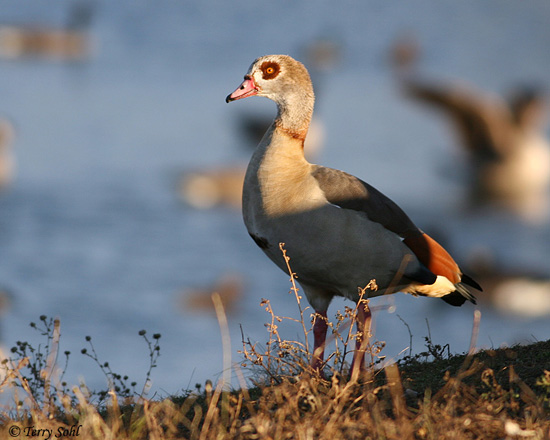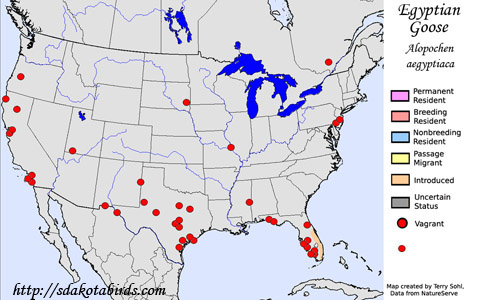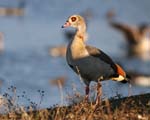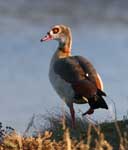| Length: 26-28 inches | Wingspan: 54-58 inches | Seasonality: Non-resident in South Dakota |
| ID Keys: Gray/white head with chestnut eye patch, yellow eyes, dark grey back, wings black and chestnut with large white patch, pink legs | ||
 The
Egyptian Goose is a native of the Nile River basin in Africa. They
have no very close relatives, and are most similar to the shelducks. They
have been domesticated for many centuries in Africa, and domesticated
Egyptian Geese also have been raised occasionally in other parts of the
world. Escaped Egyptian Geese have established breeding populations in
many locations in Europe and Asia. The American Birding Association added
the Egyptian Goose to the official North American ABA checklist in 2014,
based on well-established breeding populations in southern Florida.
The species is also occasionally seen in Texas, California, and in other
scattered locations throughout the United States, but is only considered a
local breeder in the Florida area at this time. The lone bird seen in
the photos on this page was found in November, 2005 at Arrowhead Park east
of Sioux Falls, South Dakota. It it likely an escapee from captivity
rather than a true vagrant, although given the widespread number of
sightings throughout the U.S., a vagrant cannot be ruled out.
The
Egyptian Goose is a native of the Nile River basin in Africa. They
have no very close relatives, and are most similar to the shelducks. They
have been domesticated for many centuries in Africa, and domesticated
Egyptian Geese also have been raised occasionally in other parts of the
world. Escaped Egyptian Geese have established breeding populations in
many locations in Europe and Asia. The American Birding Association added
the Egyptian Goose to the official North American ABA checklist in 2014,
based on well-established breeding populations in southern Florida.
The species is also occasionally seen in Texas, California, and in other
scattered locations throughout the United States, but is only considered a
local breeder in the Florida area at this time. The lone bird seen in
the photos on this page was found in November, 2005 at Arrowhead Park east
of Sioux Falls, South Dakota. It it likely an escapee from captivity
rather than a true vagrant, although given the widespread number of
sightings throughout the U.S., a vagrant cannot be ruled out.
Habitat: Found in wetlands and ponds in relatively open habitats. They avoid water in heavily wooded areas.
Diet: Feeds heavily on vegetative material such as algae and aquatic plants, grasses, roots, seeds, leaves, and buds, but will also feed on worms, insects, and other small invertebrates.
Behavior: Very terrestrial, often foraging on land and sometimes very far from water. They are somewhat gregarious, often found in small loose flocks and family units. They are known to be one of the most aggressive waterfowl species when near nestings sites, particularly when defending young.
Nesting: The nest of an Egyptian Goose is quite variable, both in structure and placement. Depending upon location, they may breed on open ground, in trees and shrubs (where they often take over nests of other species), in shallow burrows, or even on walls and other man-made structures. The nest is made of vegetative material (whatever dominant vegetation may be around), lined with down. The female lays between 5-12 eggs, and both parents help to incubate them. The eggs hatch after about 4 weeks and both parents tend to the young until they are old enough to fend for themselves. Egyptian Geese are monogomous and are thought to mate for life.
Song/call: The male Egyptian Goose has a quiet quacking noise that is only occasionally heard. They are much more vocal when courting, with louder honking and other noises made by the male. The female has a louder, harsher quack than the male, often used when tending to and protecting young.
Migration: Egyptian Geese are typically non-migratory.
Interactive eBird map: Click here to access an interactive eBird map of Egyptian Goose sightings
Similar Species: Generally distinctive if seen well.
Conservation Status: The species is found over a very broad geographic area (particularly when accounting for birds introduced outside of their native range), and are common in many parts of their range. The IUCN lists the Egyptian Goose as a species of "Least Concern".
Further Information: 1) WildSouthFlorida - Egyptian Goose
2) BirdingInformation - Egyptian Goose
3) Whatbird - Egyptian Goose
Photo Information: Photo taken on November 20th, 2005 - Arrowhead Park near Sioux Falls, South Dakota - by Terry Sohl
| Click below for a higher-resolution map |
 |
| South Dakota Status: Non-resident in South Dakota. The species has established breeding populations in southern Florida and perhaps elsewhere in the United States. However, birds seen in South Dakota are more likely to be escapees from captivity than actual vagrant birds. |
Additional Egyptian Goose Photos
Click for a higher-resolution version of these photos


